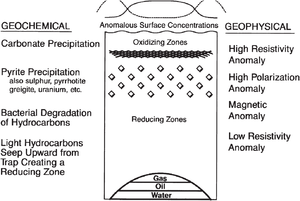Geochemical surface expression
| Exploring for Oil and Gas Traps | |

| |
| Series | Treatise in Petroleum Geology |
|---|---|
| Part | Predicting the occurrence of oil and gas traps |
| Chapter | Surface geochemical exploration for petroleum |
| Author | Dietmar Schumacher |
| Link | Web page |
| Store | AAPG Store |
Geochemical evidence of seepage
The surface geochemical expression of petroleum seepage can take many forms:
- Anomalous hydrocarbon concentrations in sediment, soil, water, and even the atmosphere
- Microbiological anomalies and the formation of paraffin dirt
- Anomalous nonhydrocarbon gases such as helium and radon
- Mineralogical changes such as the formation of calcite, pyrite, uranium, elemental sulfur, and certain magnetic iron oxides and sulfides
- Clay mineral alterations
- Radiation anomalies
- Geothermal and hydrologic anomalies
- Bleaching of red beds
- Geobotanical anomalies
- Altered acoustical, electrical, and magnetic properties of soils and sediments
Oxidation reduction zones

Bacteria and other microbes play a profound role in the oxidation of migrating hydrocarbons. Their activities are directly or indirectly responsible for many of the diverse surface manifestations of petroleum seepage. These activities, coupled with long-term migration of hydrocarbons, lead to the development of near-surface oxidation-reduction zones that favor the formation of this variety of hydrocarbon-induced chemical and mineralogical changes. This seep-induced alteration is highly complex, and its varied surface expressions have led to the development of an equally varied number of geochemical exploration techniques. Some detect hydrocarbons directly in surface and seafloor samples, others detect seep-related microbial activity, and still others measure the secondary effects of hydrocarbon-induced alteration.[1][2] Figure 1 shows a generalized model of hydrocarbon microseepage and hydrocarbon-induced effects on soils and sediments.
See also
- Principles of surface geochemical exploration
- Assumptions of surface geochemical exploration
- Limitations and uncertainties of surficial gechemistry
- Seepage activity and surficial geochemistry
- Macroseepage vs. microseepage in surficial geochemistry
References
- ↑ 1.0 1.1 Schumacher, D., 1996, Hydrocarbon-induced alteration of soils and sediments, in Schumacher, D.,and M. A. Abrams, eds., Hydrocarbon Migration and Its Near-Surface Expression: AAPG Memoir 66, p. 71–89.
- ↑ Saunders, D. F., K. R. Burson, J. J. Brown, and C. K. Thompson, 1999, Model for hydrocarbon microseepage and related near-surface alterations: AAPG Bulletin, vol. 83, p. 170–185.